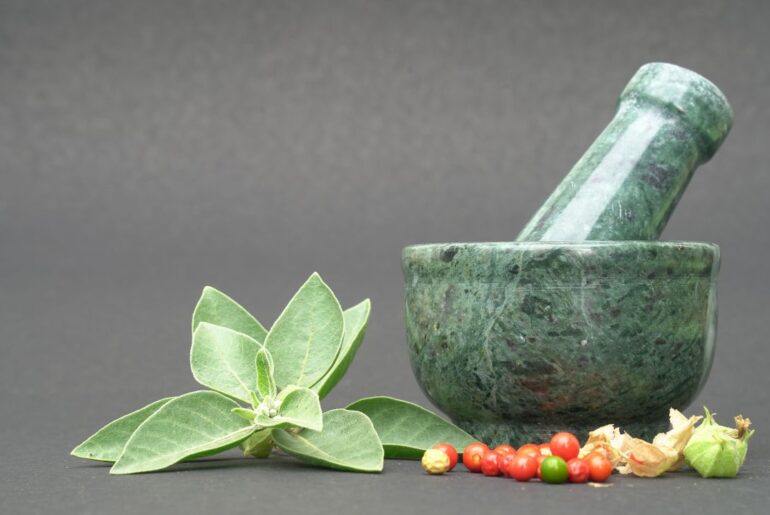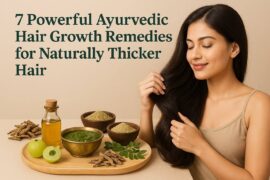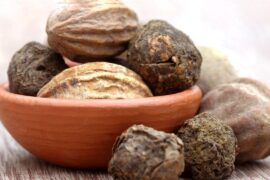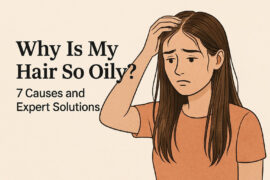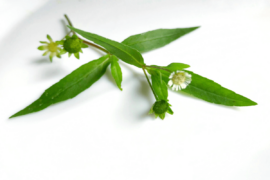For centuries, Ayurveda, the ancient Indian system of holistic medicine, has provided wisdom for maintaining health and harmony throughout the body—including the hair. Though developed thousands of miles from the African continent, Ayurvedic principles offer remarkable benefits for Black hair types, particularly the beautiful coily, kinky textures of type 4 hair.
Black hair—with its unique structure, porosity patterns, and moisture requirements—can particularly benefit from Ayurveda’s natural, oil-centered approach. Where modern commercial hair products often strip natural oils and disrupt the delicate balance of the scalp, Ayurvedic treatments nourish, strengthen, and protect the hair from within and without.
This guide explores how to harness 5,000-year-old Ayurvedic wisdom to care for contemporary Black hair textures, addressing common challenges like dryness, breakage, and scalp issues through holistic, natural treatments.
Related: The Benefits of Triphala: Ancient Ayurvedic Formula for Modern Wellness
Understanding Black Hair Structure and Needs
The Unique Architecture of Type 4 Hair
Type 4 hair, often described as kinky, coily, or zigzag-patterned, is characterized by:
- Tight curl patterns: Type 4 hair forms tight coils or zigzags (4A, 4B, and 4C), creating beautiful natural texture
- Elliptical hair follicles: Unlike straighter hair types with round follicles
- Delicate structure: Despite appearing robust, type 4 hair is often the most fragile hair type
- Special moisture requirements: The tight coils make it difficult for natural scalp oils (sebum) to travel down the hair shaft
- Shrinkage: Can shrink up to 75% of its actual length when dry
- Varying porosity: Can range from low porosity (resistant to moisture absorption) to high porosity (absorbs moisture quickly but loses it just as fast)
Common Challenges of Black Hair Types
The unique structure of Black hair types presents several common challenges:
- Moisture retention: The spiral structure prevents natural oils from traveling down the hair shaft
- Breakage susceptibility: The tight coil pattern creates stress points that are prone to breaking
- Tangling and knotting: Tightly coiled strands can easily tangle around each other
- Scalp dryness: Lower visible sebum can lead to dry, flaky scalp conditions
- Shrinkage: Can make length retention challenging
- Styling damage: Protective styles, while beneficial, can cause tension and stress at the hairline
These challenges make Ayurvedic approaches particularly valuable, as they focus on nourishing oils, strengthening herbs, and balancing scalp health—precisely what type 4 hair needs most.
Ayurvedic Dosha Theory Applied to Black Hair
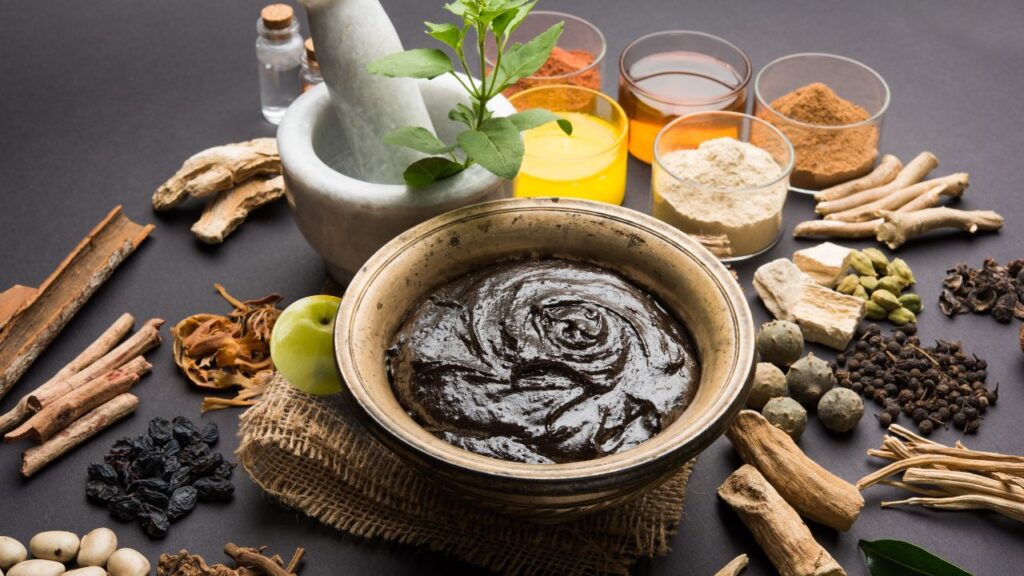
Understanding Doshas and Their Impact on Hair
In Ayurveda, all people and all hair types are understood through the lens of three primary energies or doshas:
Vata: Associated with air and space elements; creates dry, light, mobile qualities Pitta: Associated with fire and water elements; creates hot, sharp, penetrating qualities Kapha: Associated with earth and water elements; creates heavy, stable, moist qualities
While everyone has all three doshas, most people have one or two that are more dominant. Similarly, your hair will express characteristics of one or more doshas, even if you have type 4 hair.
Identifying Your Hair’s Dominant Dosha
Vata Hair in Type 4 Textures (Most Common)
- Naturally dry, brittle, and prone to breakage
- Tends to be very porous, quickly losing moisture
- Often feels rough or coarse to the touch
- Prone to split ends and excessive tangling
- Common in many 4B and 4C textures
- Breaks easily when manipulated while dry
- Often exhibits significant shrinkage
Pitta Hair in Type 4 Textures
- More moderate in texture and thickness
- Prone to scalp inflammation, itchiness, or dandruff
- May gray prematurely
- Tends to have an oilier scalp but still dry ends
- Often sensitive to harsh chemical treatments
- Can be found in 4A patterns and some 4B types
- May be more prone to scalp issues after protective styling
Kapha Hair in Type 4 Textures (Less Common)
- Thicker, denser curl patterns
- Tends to hold moisture better than other types
- Growth may be slower but steadier
- Hair feels heavier and has more natural shine
- May have issues with product buildup
- Less prone to breakage than vata types
- Sometimes seen in denser 4A patterns
Recognizing Imbalances in Black Hair
Vata Imbalance Signs: When vata becomes imbalanced in type 4 hair, several characteristic signs emerge that aggravate the already moisture-challenged nature of kinky textures. Excessive dryness and frizz become pronounced beyond the hair’s normal state, creating a perpetual thirst that conventional moisturizers struggle to quench. Increased breakage and split ends occur more frequently, with strands snapping at even the gentlest manipulation as the hair’s elasticity diminishes. Static electricity often manifests, causing hair to literally stand on end and rebel against styling attempts.
The tactile experience changes dramatically, with hair feeling like straw when touched—harsh, rough, and devoid of its natural softness. Excessive shedding or hair loss becomes apparent, with more strands than usual collecting in combs, brushes, and shower drains. Most frustratingly, those with vata-imbalanced type 4 hair experience significant difficulty retaining length, with ends breaking off at roughly the same rate as new growth appears, creating the disheartening sense of stagnation despite dedicated care.
Pitta Imbalance Signs: Pitta imbalance in type 4 hair manifests primarily through inflammatory conditions that disrupt the scalp environment and subsequently affect hair growth. Scalp irritation, redness, or itching becomes persistent, creating discomfort that can distract from daily life and potentially lead to excessive scratching and further damage. Premature graying may appear, particularly at the temples or in patches, as pitta’s excess heat affects melanin production.
The hairline or crown may show thinning as pitta’s intensity damages follicles, creating particular concern in styles where edges are prominently displayed. An unusual combination of oily scalp with persistently dry ends emerges, creating contradictory care needs that standard products cannot adequately address. Sensitivity and pain when styling become pronounced, with even gentle manipulation causing discomfort at the roots. Perhaps most visibly, inflammatory scalp conditions like seborrheic dermatitis develop or worsen, creating flaky, scaly patches that can affect both hair appearance and growth patterns if left untreated.
Kapha Imbalance Signs: Kapha imbalance in type 4 hair creates an environment of excess throughout the scalp and strands, though this is less common in naturally dry coily textures. The scalp takes on a distinctly greasy or congested feeling, heavy with oil rather than simply moisturized. Product buildup becomes stubborn and difficult to remove, requiring multiple washes or clarifying treatments to restore lightness to the hair. Growth patterns slow noticeably, with less visible progress even with dedicated care routines aimed at length retention.
The hair’s appearance and feel changes dramatically, becoming heavy and dull rather than springy and vibrant, lacking the natural luster that healthy coils can possess. Excessive oiliness concentrates particularly at the roots, creating a weighted-down effect that can diminish volume and make styles fall flat before their time. Most concerningly, kapha imbalance can make type 4 hair prone to fungal issues like scalp ringworm, as the excess moisture and oil create an environment where such organisms can thrive if the scalp’s natural balance isn’t restored.
Understanding your hair’s dominant dosha helps you choose the most effective Ayurvedic treatments, oils, and herbs for your specific hair type.
Essential Ayurvedic Herbs for Black Hair
Ayurvedic herbs offer exceptional benefits for type 4 hair, addressing many of the common challenges faced by those with kinky and coily textures. These powerful plant allies deliver nutrients directly to the hair and scalp while promoting balance throughout the body.
Amla (Indian Gooseberry): The Powerhouse for Black Hair
Amla is arguably the most valuable Ayurvedic herb for Black hair types due to its extraordinary vitamin C content—about 20 times that of an orange.
Benefits for Type 4 Hair:
- Strengthens the hair shaft, reducing breakage common in coily textures
- Preserves and enhances natural black color
- Balances scalp pH, addressing the common dryness in type 4 hair
- Provides antioxidant protection against environmental damage
- Stimulates hair growth by improving blood circulation to follicles
- Adds natural shine without weighing hair down
How to Use: Mix 2 tablespoons of amla powder with enough warm water to form a smooth paste. For additional moisture, incorporate 1 tablespoon of honey and 1 tablespoon of coconut oil. Apply to freshly washed, damp hair in sections, ensuring even distribution from roots to ends. Cover with a plastic cap and allow to sit for 30-40 minutes before rinsing thoroughly.
Bhringraj: The King of Herbs for Length Retention
Known as the “ruler of hair” in Ayurvedic medicine, Bhringraj (Eclipta Alba) excellently addresses length retention challenges common in type 4 hair.
Benefits for Type 4 Hair:
Bhringraj offers multifaceted advantages specifically tailored to the needs of type 4 hair textures. This powerful herb simultaneously promotes new hair growth while curtailing excessive shedding, addressing two common concerns for those with kinky and coily hair types. Its natural properties help maintain and enhance the rich, dark pigmentation of Black hair, potentially reducing premature graying and preserving natural color depth. Particularly beneficial after protective styling, bhringraj soothes the dry, itchy scalp conditions that often arise from braids, twists, and other tension styles by calming irritation and restoring balance to the scalp environment.
The herb’s conditioning properties penetrate tight curl patterns, softening and adding manageability without weighing down delicate strands. Natural proteins present in bhringraj provide essential strengthening for the inherently fragile structure of type 4 hair, reinforcing weak points and improving overall resilience. Perhaps most importantly, bhringraj significantly improves blood circulation to the scalp when massaged in regularly, creating the optimal environment for stimulating robust growth and addressing common concerns like thinning edges or slow length retention.
How to Use: Create a growth-stimulating oil by warming 1/2 cup of coconut oil and adding 2 tablespoons of bhringraj powder. Simmer on low heat for 5-7 minutes (do not boil). Strain and allow to cool. Apply this oil to the scalp in sections, massaging gently with fingertips. Work remaining oil through the length of hair. For best results, leave on for several hours or overnight with a protective cap before washing.
Brahmi (Bacopa Monnieri): Scalp Health Booster
Brahmi calms the nervous system while nourishing the scalp—making it ideal for addressing stress-related hair issues that disproportionately affect Black women.
Benefits for Type 4 Hair:
- Reduces scalp inflammation and flaking
- Strengthens hair roots to prevent traction alopecia (common with protective styles)
- Improves blood circulation to nourish hair follicles
- Provides cooling relief to irritated scalps
- Contains alkaloids that nourish hair follicles
- Helps manage stress-related hair thinning
How to Use: For a revitalizing scalp treatment, mix 2 tablespoons of brahmi powder with 1 tablespoon of neem powder and enough yogurt to create a smooth paste. Part hair in sections and apply directly to the scalp. Allow to sit for 30 minutes before rinsing and following with a gentle cleanser.
Hibiscus: Nature’s Conditioner for Coily Hair
Hibiscus flowers and leaves contain natural mucilage that provides exceptional slip and conditioning for even the kinkiest hair textures.
Benefits for Type 4 Hair:
Hibiscus offers numerous advantages specifically for type 4 hair textures. The natural plant mucilage enhances curl definition while simultaneously taming frizz, giving coils more clarity and form. It delivers deep conditioning without leaving heavy residue that can weigh down delicate curls. The plant’s natural properties improve hair elasticity, making strands more resilient and less prone to snapping during manipulation and styling. Regular use stimulates the hair follicles, potentially accelerating growth cycles for those seeking length retention.
Type 4 hair that often appears dull due to its spiral structure benefits from hibiscus’s ability to impart natural shine without artificial coatings. Perhaps most valuably for those with kinky textures, hibiscus creates remarkable slip that transforms the often challenging detangling process into a more manageable task, reducing stress on both the hair and its owner.
How to Use: Create a detangling rinse by steeping 2-3 hibiscus flowers (fresh or dried) in 2 cups of hot water for 30 minutes. Allow to cool completely, then strain. After shampooing, pour the hibiscus tea through hair as a final rinse, catching the liquid in a bowl and repeating 3-5 times for maximum benefit.
Fenugreek: Protein-Moisture Balance Expert
Fenugreek seeds (methi) are rich in protein and mucilage, making them perfect for addressing the protein-moisture balance crucial for healthy type 4.
Benefits for Type 4 Hair:
Fenugreek offers exceptional benefits for type 4 hair textures through its unique composition. The lecithin naturally present in fenugreek seeds provides dual action by both moisturizing and strengthening hair simultaneously—a critical combination for coily textures that tend to be both fragile and prone to dryness. Its rich protein content works to repair damaged sections along the hair shaft, helping to restore structural integrity to strands that may have been compromised by manipulation or environmental stressors. When applied regularly, fenugreek creates a beneficial coating around each strand, enhancing both slip for easier styling and adding a subtle, healthy shine to hair that typically struggles to reflect light due to its spiral pattern.
This protective coating also serves as armor against common type 4 hair concerns like breakage and split ends, helping kinky and coily hair retain hard-won length. Beyond the hair itself, fenugreek addresses the often problematic dry, itchy scalp conditions that frequently accompany type 4 hair, providing relief that supports overall hair health from the foundation. Many users with type 4 textures also report noticeably reduced shedding with consistent fenugreek use, suggesting it may help strengthen the hair right from the follicle.
How to Use: Soak 1/4 cup of fenugreek seeds overnight in water. In the morning, grind them into a smooth paste using a blender. Apply to clean, damp hair focusing on the scalp and roots. Cover with a shower cap and leave on for 30 minutes before rinsing thoroughly.
Neem: The Scalp Purifier
Neem addresses many of the scalp issues that can arise with protective styling and product buildup.
Benefits for Type 4 Hair:
- Strong antibacterial and antifungal properties combat scalp infections
- Reduces dandruff and scalp itchiness
- Balances oil production without stripping natural oils
- Purifies follicles, promoting healthier growth
- Soothes inflammatory scalp conditions
- Can help with persistent dandruff and flaking
How to Use: Mix 2 tablespoons of neem powder with enough water to make a paste. Apply directly to the scalp in sections, focusing on problem areas. Leave on for 20-30 minutes before rinsing thoroughly. Can be mixed with other herbs like brahmi or amla for additional benefits.
Ayurvedic Oils and Oil Blends for Black Hair
Base Oils Most Beneficial for Type 4 Hair
Coconut Oil: The Ultimate Penetrating Oil
- Penetrates the hair shaft to provide deep conditioning
- Prevents protein loss during washing
- Excellent for high porosity type 4 hair that loses moisture quickly
- Traditional pre-shampoo treatment in many cultures
- Rich in lauric acid which has antimicrobial properties
- Best applied to damp hair to seal in moisture
Castor Oil: The Growth Stimulator
- Thick, viscous oil perfect for sealing moisture in type 4 hair
- Rich in ricinoleic acid that improves blood circulation to follicles
- Excellent for edges and thinning areas
- Can be slightly diluted with lighter oils for easier application
- Prevents moisture loss through its sealing properties
- Often used in “loc method” for type 4 hair
Sesame Oil: The Warming Nourisher
- Excellent for vata-dominant dry, brittle hair
- Warming properties stimulate the scalp and follicles
- Penetrates deeply without being overly heavy
- Rich in minerals like zinc, copper, and calcium
- Improves circulation to the scalp
- Traditional Ayurvedic choice for hair oiling
Sweet Almond Oil: Balance for All Doshas
- Light enough for low porosity hair but moisturizing enough for high porosity
- Rich in vitamin E, proteins, and zinc
- Soothes scalp inflammation and irritation
- Absorbs well without being greasy
- Provides slip for detangling
- Suitable for all three dosha types
Medicated Oils (Herb-Infused) for Specific Hair Concerns
Bhringraj Oil for Growth and Thickness Ideal for: Thinning edges, slow growth, breakage-prone hair
Ingredients:
- 1 cup organic sesame or coconut oil
- 1/4 cup dried bhringraj leaves/powder
- 1 tbsp fenugreek seeds (optional for added strengthening)
Preparation:
- Warm the oil in a pan over low heat
- Add the herbs and gently heat for 30 minutes (do not boil)
- Remove from heat and let cool overnight
- Strain through cheesecloth and store in a dark glass bottle
Application: Massage into the scalp focusing on thinning areas. Work through the length of hair and leave in for at least 30 minutes before washing, or overnight for deeper treatment.
Amla-Brahmi Oil for Scalp Health and Conditioning Ideal for: Dry, flaky scalp, irritation after protective styling, dull hair
Ingredients:
- 1 cup coconut oil
- 2 tbsp amla powder
- 2 tbsp brahmi powder
- 1 tsp neem powder (optional for extra antimicrobial benefits)
Preparation:
- Warm the oil in a pan over low heat
- Add the herbs and gently heat for 30 minutes (do not boil)
- Remove from heat and let cool overnight
- Strain through cheesecloth and store in a dark glass bottle
Application: Apply to the scalp in sections, gently massaging in circular motions. Work through length of hair and cover with a shower cap. Leave for 1-2 hours or overnight before washing.
Hibiscus-Rose Oil for Moisture and Shine Ideal for: Extremely dry, dull hair, fuzzy or undefined curl pattern
Ingredients:
- 1 cup almond or grapeseed oil
- 2 tbsp dried hibiscus flowers
- 1 tbsp dried rose petals
- 1 tsp vitamin E oil (optional preservative)
Preparation:
- Warm the oil in a pan over low heat
- Add the flowers and gently heat for 30 minutes (do not boil)
- Remove from heat and let cool overnight
- Strain through cheesecloth and store in a dark glass bottle
Application: Apply to damp hair after washing to seal in moisture. Focus on ends and dryer portions of hair. Can be used as a daily moisturizer for defined, shiny coils.
Oil Application Techniques for Type 4 Hair
Pre-Shampoo Oil Treatment (Optimal for Moisture Retention)
- Section clean, dry hair into 4-8 manageable parts
- Apply oil generously to each section, focusing first on the scalp
- Massage the scalp with fingertips (not nails) in circular motions
- Work the oil through the length of each section, paying special attention to ends
- Cover with a shower cap or plastic bag, then wrap with a warm towel
- Leave for at least 30 minutes, preferably 1-2 hours
- Shampoo thoroughly, may require 2 washes for complete removal
Warm Oil Scalp Massage (Best for Growth Stimulation)
- Slightly warm your chosen oil by placing the bottle in hot water
- Using a dropper, apply oil directly to the scalp in rows
- With fingertips, massage the scalp using:
- Small circular motions at the crown
- Front-to-back strokes along the scalp
- Gentle pressure at the temples and behind the ears
- Continue for 5-10 minutes to stimulate circulation
- Cover with a warm towel for 20 minutes
- Follow with regular shampooing
LOC Method with Ayurvedic Oils (Ideal for Moisture Sealing)
- After washing, apply a water-based Leave-in conditioner
- Apply a small amount of Ayurvedic Oil to each section while still damp
- Seal with a Cream or butter-based product
- This method locks in moisture for days, reducing daily manipulation
- Particularly effective with lighter oils like almond or grapeseed as the “O” step
DIY Ayurvedic Hair Treatments for Black Hair
Amla-Fenugreek Strengthening Mask
Perfect for: Breakage-prone, weak strands, hair that stretches and breaks when wet
Ingredients:
- 2 tablespoons amla powder
- 2 tablespoons fenugreek (methi) powder or soaked and ground seeds
- 1 tablespoon hibiscus powder (optional for slip)
- 1/4 cup plain yogurt
- 1 tablespoon honey
Directions:
- Mix all powders together in a bowl
- Add yogurt and honey, stirring to form a smooth paste
- Apply to clean, damp hair in sections, focusing on areas prone to breakage
- Cover with a plastic cap and leave for 30-45 minutes
- Rinse thoroughly and follow with a moisturizing conditioner
- Use every 2-3 weeks for protein-moisture balance
Brahmi-Bhringraj Scalp Treatment
Perfect for: Thinning edges, slow growth, itchy or irritated scalp
Ingredients:
- 2 tablespoons brahmi powder
- 2 tablespoons bhringraj powder
- 1 tablespoon neem powder
- Hot water (enough to make a paste)
- 1 teaspoon coconut oil
Directions:
- Mix all powders in a glass or ceramic bowl
- Slowly add hot water, stirring until a smooth paste forms
- Add coconut oil and mix well
- Part hair in small sections and apply directly to the scalp with fingertips
- Once scalp is covered, put on a plastic cap
- Leave for 30 minutes
- Rinse thoroughly and follow with gentle shampoo if needed
- Use weekly for best results
Hibiscus-Aloe Moisture Infusion
Perfect for: Extremely dry, thirsty hair, high porosity types
Ingredients:
- 3 tablespoons dried hibiscus flowers (or 2 tablespoons hibiscus powder)
- 1/4 cup fresh aloe vera gel
- 1 tablespoon honey
- 2 tablespoons rose water
- 1 tablespoon sweet almond oil
Directions:
- If using dried flowers, steep in hot water for 20 minutes, then strain
- Blend aloe vera gel until smooth
- Mix hibiscus (powder or strained liquid), aloe, honey, rose water, and oil
- Apply to clean, damp hair in sections
- Cover with a plastic cap and leave for 20-30 minutes
- Rinse with cool water (no shampoo needed)
- Style as usual
- Can be used weekly as a refreshing treatment
Neem-Rosemary Clarifying Rinse
Perfect for: Product buildup, flaky scalp, after removing protective styles
Ingredients:
- 2 tablespoons neem powder
- 1 tablespoon dried rosemary (or 5 drops rosemary essential oil)
- 2 cups hot water
- 1 tablespoon apple cider vinegar
- 10 drops tea tree oil (optional)
Directions:
- Steep neem powder and rosemary in hot water for 30 minutes
- Strain carefully through a fine mesh sieve or cheesecloth
- Add apple cider vinegar and tea tree oil if using
- After shampooing, pour the rinse over your hair and scalp
- Massage gently for 1-2 minutes
- Leave on for 5 minutes
- Rinse with cool water
- Use monthly or after removing protective styles
Triphala Hair Growth Oil
Perfect for: Overall hair health, balanced approach for all dosha types
Ingredients:
- 1 tablespoon triphala powder
- 1 cup sesame oil
- 1 teaspoon brahmi powder
- 1 teaspoon bhringraj powder
- 1/2 teaspoon fenugreek seeds
Directions:
- Warm sesame oil in a small pan over low heat
- Add all herbs and seeds
- Simmer gently for 30 minutes, stirring occasionally
- Remove from heat and let cool completely
- Strain through cheesecloth
- Store in a dark glass bottle
- Apply to scalp and hair twice weekly, leaving in for at least one hour before washing
- For best results, warm slightly before each use
Holistic Ayurvedic Approach to Hair Health
Diet Recommendations for Healthy Black Hair
According to Ayurveda, what you eat directly affects your hair’s growth, strength, and appearance. For Black hair types, focusing on these nutrients is particularly beneficial:
Foods Rich in Iron Iron deficiency can lead to hair loss and is more common among women of African descent. Include:
- Dark leafy greens like kale, collards, and spinach
- Lentils and beans
- Grass-fed liver and other organ meats
- Blackstrap molasses
- Pumpkin and sesame seeds
Foods Rich in Biotin Biotin strengthens keratin infrastructure in the hair. Include:
- Eggs (especially the yolks)
- Sweet potatoes
- Avocados
- Nuts and seeds
- Legumes
Foods Rich in Omega-3 Fatty Acids These healthy fats nourish the scalp and reduce inflammation. Include:
- Fatty fish like salmon and mackerel
- Flaxseeds and chia seeds
- Walnuts
- Sea vegetables like dulse and kelp
Hydrating Foods Keeping the body well-hydrated supports healthy hair moisture from within. Include:
- Cucumber
- Celery
- Watermelon
- Coconut water
- Herbal teas
Ayurvedic Spices for Hair Health
- Turmeric: Anti-inflammatory and circulatory stimulant
- Fenugreek: Promotes growth and strengthens from within
- Cinnamon: Improves circulation to the scalp
- Black pepper: Enhances nutrient absorption
- Ginger: Stimulates circulation and reduces inflammation
Foods to Reduce or Avoid
- Processed foods with synthetic ingredients
- Excessive sugar, which increases inflammation
- Refined carbohydrates
- Excessive caffeine, which can dehydrate the body
- Alcohol, which depletes nutrients and dehydrates
Ayurvedic Herbs to Take Internally
Triphala
- Cleanses the digestive system and removes toxins
- Promotes absorption of nutrients needed for hair health
- Balances all three doshas
- Dosage: 1/2 teaspoon powder with warm water at night, or 2 tablets daily
Ashwagandha
- Reduces stress hormones that can contribute to hair loss
- Supports healthy sleep, essential for hair growth
- Balances hormones that affect hair growth cycles
- Dosage: 1/2 teaspoon powder in warm milk before bed, or 1-2 capsules daily
Shatavari
- Particularly helpful for hormone-related hair issues
- Rich in phytoestrogens that can support women’s hair health
- Deeply nourishing adaptogen
- Dosage: 1/2 teaspoon powder in warm milk, or 1-2 capsules daily
Amla (Amalaki)
- Can be taken internally as well as used externally
- One of the richest natural sources of vitamin C
- Supports collagen production for hair strength
- Dosage: 1/2 teaspoon powder in water, or 1-2 capsules daily
Stress Management Techniques for Hair Health
Chronic stress can directly impact hair health by triggering hormonal imbalances and redirecting nutrition away from “non-essential” functions like hair growth. Ayurveda offers several stress-reduction techniques particularly beneficial for hair health:
Scalp Massage (Shiro Abhyanga)
- Use fingertips to massage the scalp in small, circular motions
- Practice for 5-10 minutes daily, with or without oil
- Focus on the crown, temples, and base of the skull
- Benefits: Releases tension, improves blood flow, activates marma points
Meditation for Hair Health
- Practice 10-20 minutes daily, ideally in the morning
- Focus on breathing deeply and releasing tension
- Visualize nourishing energy flowing to your scalp and hair
- Benefits: Reduces cortisol (stress hormone) levels that can impact hair growth
Pranayama (Breathing Exercises)
- Sheetali (Cooling Breath): Curl the tongue and inhale through it like a straw, then exhale through the nose
- Nadi Shodhana (Alternate Nostril Breathing): Alternately close one nostril while breathing through the other
- Practice for 5 minutes daily, ideally before meditation
- Benefits: Balances the nervous system and reduces stress hormones
Hair-Positive Self-Talk
- Practice affirmations that celebrate your natural hair
- Replace negative thoughts about your hair with gratitude
- Create a positive ritual around your hair care routine
- Benefits: Reduces the stress response triggered by negative self-image
Sleep Recommendations for Optimal Hair Growth
Hair grows primarily during sleep when the body is in repair mode. Optimize your sleep for hair health with these Ayurvedic recommendations:
Timing: In Ayurveda, the optimal sleep schedule is 10pm-6am, when the body’s natural repair processes are most active
Sleep Surface: Use a silk or satin pillowcase to reduce friction and moisture loss from hair
Protective Nighttime Styling:
- Pineapple method (gathering hair loosely at the crown)
- Silk/satin bonnet or scarf
- Loose braids or twists that don’t create tension
Pre-Sleep Routine:
- Apply a small amount of warmed oil to your scalp and massage gently
- Practice “legs up the wall” pose for 5-10 minutes to improve circulation
- Drink warm milk with a pinch of nutmeg for better sleep quality
Integrating Ayurveda with Modern Black Hair Care Practices
Combining Ayurvedic Treatments with Protective Styling
Pre-Protective Style Prep
- Deep cleanse with an Ayurvedic herbal wash (like shikakai or amla mixed with water)
- Apply a brahmi-bhringraj oil treatment to the scalp 24 hours before styling
- Use a moisturizing hibiscus rinse as a final step before installation
During Protective Style Maintenance
- Mix 1 part Ayurvedic oil (like bhringraj or amla) with 5 parts rose water in a spray bottle for regular scalp refreshing
- Apply diluted neem oil to the scalp weekly to prevent fungal issues
- For braids and twists, use a light hibiscus oil on the lengths to maintain moisture
Post-Protective Style Recovery
- Apply a gentle triphala rinse to remove buildup without stripping
- Use a fenugreek-yogurt mask to restore protein-moisture balance
- Follow with an intensive amla oil treatment to strengthen hair after manipulation
Natural Product Formulations with Ayurvedic Ingredients
DIY Ayurvedic Shampoo Alternative
- 2 tablespoons shikakai powder
- 1 tablespoon amla powder
- 1 tablespoon fenugreek powder
- Water to form a paste
Directions: Mix ingredients, adding water gradually until a paste forms. Apply to wet hair, massage gently, and rinse thoroughly. This cleanses without stripping natural oils.
Ayurvedic Leave-In Conditioner
- 1 cup distilled water
- 2 tablespoons aloe vera gel
- 1 tablespoon glycerin
- 1 teaspoon bhringraj powder steeped in the water and strained
- 5 drops rosemary essential oil
Directions: Combine all ingredients in a spray bottle. Shake well before each use. Apply to damp hair after washing for moisture and detangling.
Ayurvedic Edge Control
- 2 tablespoons flaxseed gel (homemade or store-bought)
- 1/2 teaspoon castor oil
- 1/4 teaspoon amla oil
- 1/4 teaspoon brahmi powder
- 5 drops rosemary essential oil
Directions: Mix all ingredients until well combined. Apply to edges with a small brush or fingertips. This provides hold while also nourishing and strengthening edges.
Ayurvedic Hair Butter for Sealing
- 2 ounces shea butter
- 1 tablespoon coconut oil
- 1 tablespoon almond oil
- 1 teaspoon amla oil
- 1/2 teaspoon hibiscus powder
- 5 drops lavender essential oil
Directions: Melt shea butter and oils together. Remove from heat and stir in hibiscus powder and essential oil. Allow to cool, then whip until fluffy. Use to seal ends and protect hair from moisture loss.
Creating a Sustainable Ayurvedic Hair Care Routine
Daily Practices
- Light scalp massage with fingertips (1-2 minutes)
- Spritz hair with moisture spray containing rose water and aloe
- Protect hair at night with satin/silk scarf or pillowcase
Weekly Practices
- Oil pre-wash treatment with appropriate Ayurvedic oil blend
- Gentle cleansing with herbal wash or mild shampoo
- Deep conditioning with Ayurvedic ingredients
- Sealing moisture with Ayurvedic butter or oil blend
Monthly Practices
- Scalp detoxification with neem-based treatment
- Protein treatment with fenugreek or henna
- Clarifying rinse with triphala or shikakai
- Hair growth oil treatment with bhringraj left overnight
Seasonal Adjustments
- Winter: Increase oil treatments; use heavier butters for sealing
- Summer: Lighter oils; increase protective styling to shield from sun
- Spring/Fall: Balance treatments focusing on scalp health and growth
Sample Regimens for Different Hair Needs
For Extremely Dry, Breakage-Prone Hair (Vata-Dominant)
Morning:
- Spritz with rose water and aloe vera mixture
- Apply a small amount of whipped shea-coconut cream to ends
Evening:
- Warm oil scalp massage with sesame or almond oil (3-5 minutes)
- Cover with satin bonnet overnight
Weekly:
- Pre-poo treatment with warm sesame oil infused with bhringraj
- Gentle cleansing with shikakai powder mixed with coconut milk
- Deep condition with hibiscus-fenugreek mask
- Style with minimal manipulation
Monthly:
- Henna treatment (mixed with amla to prevent color change if desired)
- Full body abhyanga (oil massage) to balance overall vata
Dietary Support:
- Increase healthy fats like ghee, coconut oil, avocados
- Warm, nourishing foods like sweet potatoes, oats, and stews
- Vata-balancing spices: ginger, cinnamon, cardamom
For Scalp Issues and Thinning (Pitta-Dominant)
Morning:
- Apply cooling brahmi-coconut oil to edges and thinning areas
- Style with minimal heat or tension
Evening:
- Gentle scalp massage with cooling coconut or brahmi oil
- Apply aloe vera gel directly to scalp irritation
Weekly:
- Pre-wash treatment with neem-infused coconut oil
- Cleanse with gentle amla-shikakai wash
- Apply cooling hibiscus-aloe mask
- Rinse with rose water
Monthly:
- Detoxifying scalp treatment with triphala
- Bhringraj oil treatment for thinning areas
- Cooling hair rinse with hibiscus and rose
Dietary Support:
- Reduce spicy, acidic, and fermented foods
- Increase cooling foods like cucumber, coconut, and leafy greens
- Pitta-balancing herbs: coriander, mint, fennel
For Product Buildup and Under-Active Growth (Kapha-Dominant)
Morning:
- Stimulating scalp massage with rosemary-infused sesame oil
- Light styling with minimal product
Evening:
- Dry scalp massage with fingertips to stimulate circulation
- No heavy oils at night
Weekly:
- Pre-wash treatment with stimulating bhringraj-sesame oil (30 minutes)
- Clarifying wash with shikakai and apple cider vinegar
- Lighter conditioning with aloe and fenugreek
- Style with minimal product
Monthly:
- Triphala scalp scrub to remove buildup
- Stimulating scalp treatment with ginger and black pepper-infused oil
- Clarifying rinse with neem
Dietary Support:
- Reduce heavy, oily, and sweet foods
- Increase pungent, bitter, and astringent tastes
- Kapha-balancing spices: black pepper, ginger, cloves
Case Studies and Success Stories
Amara’s Journey with Type 4C Hair
Amara had struggled with extremely dry, breakage-prone 4C hair for years. No matter how many high-end moisture products she used, her hair remained brittle and refused to retain length. After learning she had Vata-dominant hair, she implemented these Ayurvedic changes:
Implemented Changes:
- Weekly pre-poo with warm sesame oil infused with bhringraj and amla
- Switched from commercial shampoo to shikakai-amla herbal wash
- Added fenugreek seeds to her diet daily
- Started taking triphala supplements for internal balance
- Used hibiscus-infused aloe vera gel for daily moisture
Results After 6 Months:
- Retained 3 inches of length (more than the previous 2 years combined)
- Significantly reduced breakage and split ends
- Hair remained moisturized for days between washes
- Scalp flakiness completely resolved
- Enhanced curl definition and softness
“I used to think my hair was just ‘bad’ or too difficult,” shares Amara. “Ayurveda taught me that my hair wasn’t being properly nourished inside and out. The transformation has been amazing—and most of these treatments cost a fraction of what I was spending before.”
Micah’s Healing From Traction Alopecia
Micah had developed significant thinning at his temples and hairline after years of tight braided styles. Based on his symptoms, he identified with Pitta-dominant hair issues:
Implemented Changes:
- Daily application of brahmi-bhringraj oil to thinning areas
- Monthly scalp treatments with neem and amla
- Reduced tension in styling and opted for looser protective styles
- Added cooling herbs to his diet, including coriander and fennel
- Evening scalp massage with cooling coconut oil
- Started taking ashwagandha to manage stress
Results After 8 Months:
- 80% regrowth in previously bald temple areas
- Reduced scalp inflammation and irritation
- New growth appeared stronger and more resilient
- Overall hair thickness improved
- Learned sustainable styling practices that didn’t sacrifice appearance
“I had tried minoxidil and other growth treatments without much success,” Micah explains. “The Ayurvedic approach helped me understand that my hair loss wasn’t just about the hair itself, but about inflammation, tension, and internal balance. The holistic approach made all the difference.”
Leila’s Transformation From Dull to Vibrant
Leila had thick type 4B hair that was dull, lacked definition, and suffered from product buildup. Her Kapha-dominant hair needed a different approach:
Implemented Changes:
- Weekly clarifying washes with shikakai and apple cider vinegar
- Stimulating scalp massage with rosemary and black pepper-infused oil
- Reduced heavy creams and butters in favor of lighter oils
- Added triphala to her nighttime routine
- Incorporated more pungent spices in her diet
- Used hibiscus tea as a final rinse for shine
Results After 4 Months:
- Enhanced curl definition and natural shine
- Hair felt lighter and had more movement
- Growth rate increased by approximately 30%
- Product performed better due to removal of buildup
- Scalp health improved, with no more itchiness or congestion
“I always thought my hair needed heavy products to look good, but they were actually weighing it down and causing buildup,” says Leila. “The Ayurvedic approach helped me understand my hair’s actual needs rather than just following trends. The stimulating herbs and clarifying treatments transformed my hair completely.”
Conclusion
Ayurveda offers a profound and holistic approach to caring for Black hair that addresses the unique challenges of type 4 textures. By understanding your hair’s dosha characteristics and working with natural herbs, oils, and lifestyle practices, you can create a sustainable hair care routine that promotes health from the inside out.
The integration of ancient Ayurvedic wisdom with modern Black hair care needs provides a powerful framework that:
- Respects the natural structure and needs of coily, kinky hair
- Addresses common issues like dryness, breakage, and scalp health
- Uses natural ingredients that nourish rather than deplete the hair
- Connects hair health to overall well-being
- Offers sustainable, cost-effective alternatives to commercial products
Remember that Ayurveda is about balance and individualization. Your journey may require experimentation to find the exact combinations of herbs, oils, and practices that work best for your unique hair. Be patient with the process—sustainable, healthy hair growth takes time, but the results are worth the investment.
As you explore Ayurvedic hair care, you may find yourself reconnecting with ancient wisdom that honors the inherent beauty of your natural hair. This connection can be as nourishing to your spirit as the herbs are to your hair, creating a beautiful synergy of health, heritage, and holistic well-being.
Frequently Asked Questions
Is Ayurveda compatible with chemical treatments like relaxers or color?
Ayurveda generally promotes natural approaches, but if you choose to use chemical treatments, Ayurvedic practices can help mitigate potential damage. Pre-treat the hair with protective oils before chemical services, and use deep nourishing treatments afterward. Henna and indigo can be natural alternatives to chemical color, though they aren’t compatible with all chemical processes—research thoroughly before combining.
How do I know which dosha is dominant in my hair type?
Observe your hair’s natural tendencies: if it’s dry, brittle, and prone to breakage, vata likely dominates; if your scalp is irritated and you experience premature graying, pitta may be prominent; if your hair is thick, heavy, and prone to oiliness, kapha characteristics are present. Most Black hair types show primarily vata characteristics (dryness), often with secondary pitta or kapha influences.
Can Ayurvedic treatments help with postpartum hair loss?
Yes. Postpartum hair loss (telogen effluvium) responds well to Ayurvedic treatments. Brahmi and bhringraj oils stimulate the scalp and support new growth, while ashwagandha and shatavari help balance hormones that affect hair growth cycles. Consistency is key—begin with a twice-weekly oil treatment and internal supplements like ashwagandha (after consulting your healthcare provider).
Will Ayurvedic herbs change my natural hair color?
Some herbs can subtly affect hair color. Henna imparts a reddish tone, amla can darken hair, and bhringraj may intensify natural black pigment over time. If you wish to avoid color changes, use these herbs in diluted forms or pair color-enhancing herbs with others that moderate their effects. For example, mix amla with hibiscus to reduce its darkening properties while retaining its strengthening benefits.
How do I measure results from Ayurvedic hair care?
Take “before” photos and measurements of your hair in its natural state. Document specific issues like breakage, dryness, or scalp conditions. After implementing Ayurvedic practices for at least 8-12 weeks, assess changes in these areas. Track metrics like: reduced shedding during washing, increased length retention, improved moisture retention time, enhanced curl definition, and scalp health improvements.
How can I simplify Ayurvedic hair care for my busy lifestyle?
Start with one Ayurvedic practice—like a weekly oil pre-wash treatment—and gradually add more as you see benefits. Prepare larger batches of treatments and freeze in ice cube trays for single-use portions. Combine steps where possible; for example, add herbs to your regular conditioner or use multi-purpose herbs like amla that address several concerns simultaneously. Even simplified Ayurvedic routines can provide significant benefits.
Are there any Ayurvedic herbs to avoid for certain hair conditions?
Those with very sensitive scalps should approach neem and fenugreek cautiously, as they can be stimulating. Those with fine, low-density hair may find coconut oil too heavy. Henna should be avoided if you plan to chemically color your hair in the future. Always perform patch tests with new herbs and oils, particularly if you have allergies or skin sensitivities.
How do I store homemade Ayurvedic hair preparations?
Oil preparations should be stored in dark glass bottles away from direct sunlight and heat, where they typically last 3-6 months. Refrigerate fresh herb pastes and use within 3-5 days, or freeze in portions for up to 3 months. Dry herb mixtures should be kept in airtight containers in a cool, dry place and used within 6 months. Add vitamin E or grapefruit seed extract as a natural preservative to extend shelf life.

